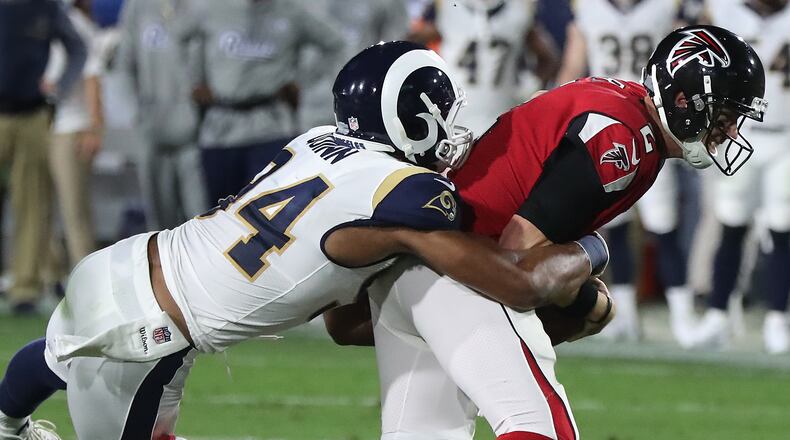The Falcons picked Matt Ryan No. 3 overall in the 2008 draft. Three other quarterbacks were selected within the first two rounds that year: Joe Flacco, Brian Brohm, and Chad Henne. All four QBs fit the prototype of the time: big and tall pocket passers. None were athletically above average, which was considered a luxury.
The Bengals picked Joe Burrow No. 1 overall in the 2020 draft. Four other quarterbacks were selected within the first two rounds: Tua Tagovailoa, Justin Herbert, Jordan Love and Jalen Hurts. None of the five players perfectly fits the pocket passer prototype. All are above average athletes, which now might be a necessity for the best players at the position.
The Falcons clearly made the right choice drafting Ryan, the best player in franchise history. No other Falcons player has been voted league MVP. Ryan turned 35 years old this month and had an off year in 2019. But it’s reasonable to believe he still can be a top QB with the right circumstances (more on that later).
Still, Ryan no longer is the kind of QB that’s favored in the NFL. Pure pocket passers are on their way out. Dual-threat quarterbacks are in.
As the NFL moves to an era of dynamic, running quarterbacks the Falcons are relying on one from a different time. Accuracy, smarts and toughness are among Ryan’s strengths. Those attributes age well. Relatively limited mobility is one of his weaknesses. That gets worse with age.
Dual-threat quarterbacks are among the best in the league now. Ryan was league MVP in 2016. Old-school QB Tom Brady won it the next year . The last two MVPs, Patrick Mahomes and Lamar Jackson, are dual threats.
Mahomes was the youngest QB to win MVP until Jackson did it. Mahomes won the last Super Bowl with the Chiefs. Among the 12 teams in the 2019 playoffs, eight started QBs who can run.
Dual-threat quarterbacks keep coming in the draft. Jameis Winston and Marcus Mariota went one-two at the top of the 2015 draft. From 2015 through 2020, only two of 17 quarterbacks selected among the top 10 picks weren’t especially mobile: Jared Goff and Josh Rosen.
Dual-threat QBs have a long history in the NFL. Fran Tarkenton was a pioneer in the 1960s. John Elway, Randall Cunningham, Steve Young and Kordell Stewart followed.
Former Falcons quarterback Michael Vick is the career leader in rushing yards for QBs. Vick was a bridge to the likes of Cam Newton, Aaron Rodgers and Russell Wilson. Now Mahomes and Jackson lead the dual-threat pack.
It used to be that being a mobile QB mostly meant scrambling to pass. They made plays out of the pocket when things broke down. Now NFL teams are building around dual-threat QBs. They run to make plays, not just as an emergency option.
The Falcons don’t have that element with Ryan. He can move in the pocket to buy time. He will run for important yards when there’s an opening. But Ryan isn’t a dual threat. Give him a clean pocket and he’ll make good throws but he’s not usually making something happen on his own.
That means the Falcons must put Ryan in the right scheme with the right personnel. They did that during his 2016 MVP season. Ryan had several good pass targets other than Julio Jones, dynamic running back Devonta Freeman and coordinator Kyle Shanahan running an attack heavy on play-action (fake handoffs before passes).
Most importantly, the Falcons had a good offensive line in 2016. Ryan’s two worst seasons as a veteran were 2013 and 2019. It’s no coincidence that those probably are the two worst years for Falcons pass protection during that span.
All quarterbacks are bothered by pressure in the pocket. Dual-threat QBs have a better chance of escaping it. They have more options when they get outside the pocket. The possibility of designed runs adds another element for the defense to consider.
The Chiefs won it all last season despite so-so pass blocking. That’s the Mahomes effect. His athleticism and creativity make up for leaky protection. The Falcons don’t have the same luxury.
Pro Football Focus notes that Ryan took a “a high number of avoidable sacks” in 2019. It won’t go well for the Falcons if the offensive line doesn’t get significantly better. The decline of that unit is the No. 1 reason the Falcons were average offensively last season.
It's not clear the Falcons' line will be much better in 2020. I do like the plan to use more wide zone runs. The Falcons mastered those with Shanahan, which made play-action passes devastating. But I wonder if those runs will be as effective with Todd Gurley or any other running back on the roster.
The Falcons will ride Ryan for as long as they can. ESPN recently ranked NFL quarterbacks in order of how much their teams are financially committed to them. After restructuring Ryan's contract following last season, the Falcons realistically can't cut him until the 2022 offseason.
Among the eight quarterbacks higher on ESPN’s list, only Goff and Kirk Cousins are pocket passers. The Rams gave Goff a huge contract before last season and he regressed. Cousins parlayed a good year into $61 million guaranteed.
Ryan is a better investment than Goff and Cousins. Dual-threat QBs are taking over the NFL, but that doesn’t mean Ryan can’t be among the best. Fellow pocket passers Drew Brees and Cousins had very good seasons in 2019.
The Falcons will have to build the right offense for Ryan. Unlike the new school of dual-threat QBs, he’s not apt to make things happen on his own.
About the Author
The Latest
Featured


